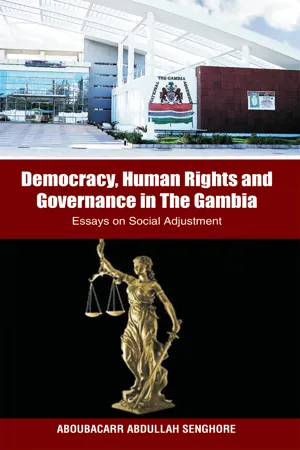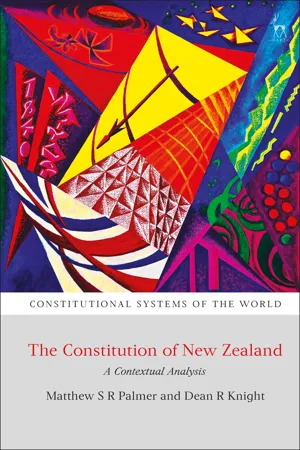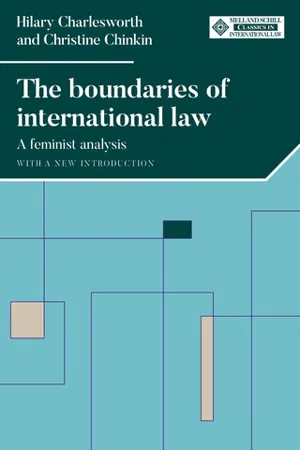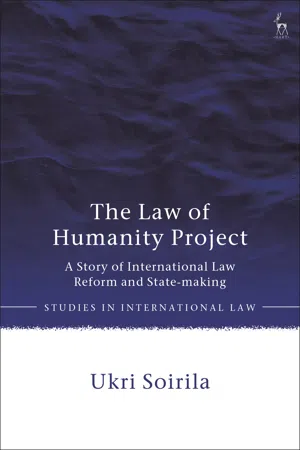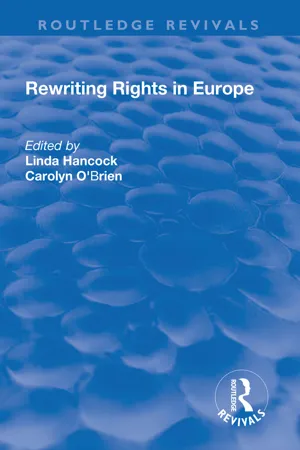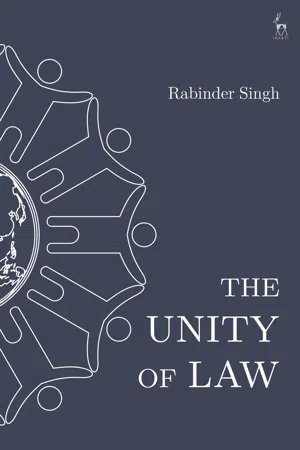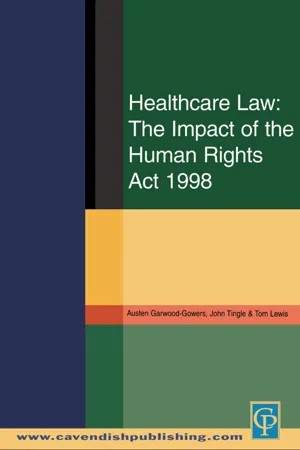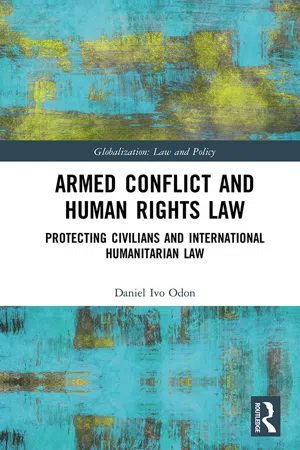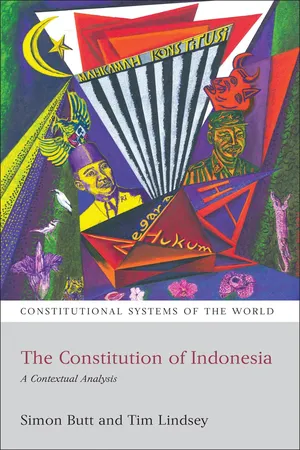Law
National Human Rights
National human rights refer to the fundamental rights and freedoms that are recognized and protected by the laws and institutions of a specific country. These rights encompass civil, political, economic, social, and cultural aspects, and are intended to ensure the dignity, equality, and well-being of all individuals within the nation's jurisdiction. National human rights laws are often aligned with international human rights standards and treaties.
Written by Perlego with AI-assistance
Related key terms
10 Key excerpts on "National Human Rights"
- eBook - ePub
Democracy, Human Rights and Governance in The Gambia:
Essays on Social Adjustment
- Abdullah Senghore(Author)
- 2018(Publication Date)
- CENMEDRA(Publisher)
32 This is why I have referred to al-Shātibi’s approach of dividing maslahah or human interest into darūriyyāt, hājiyyāt and tahsiniyyāt as the best way of explaining the precise nature of rights in Islam. Thus what matters is not to define the concept of human rights in Islam or to say what they mean but it should be to say what they are, where they should be placed and how they can be actualized in an Islamic state. And for the last one I believe institutions like Majlis al – shūrā, qādā’, and hisbah can be effective mechanisms of implementation. Before I end my discussion on this issue let me take a brief look at the position of human rights in national and international law in the past.II. Human Rights in National Legal SystemsHuman rights occupy prominent positions in the national constitutions and legal systems of many countries of modern times including almost all Muslim countries. In countries like United States of America, India, Nigeria, Pakistan, Malaysia, Indonesia, The Gambia, Senegal, Guinea Conakry, Mali, South Africa and Ghana, fundamental rights are incorporated into the supreme law of the land or the constitution, and therefore, unchangeable by the executive authorities through an amendment process or by way of executive orders.II.a. Origins of Domestic Human RightsDomestic human rights law is said to have begun emerging in Europe as early as 1215 when the Magna Carta, the Great Charter in which the fundamental rights and privileges of the English people were guaranteed, appeared during the reign of King John and in 1688 when the British Parliament enacted the 1688 Bill of Rights.11 This was followed later by the American Declaration of Independence and The Bill of Rights and the French Declaration of the Rights of Man of 1776 and 1789 respectively. Unlike domestic human rights law, the international law of human rights is of a very recent development. Prior to 1945, it was still not developed because international law was generally not concerned with how states treated their citizens. Such matters were regarded as falling under the domestic jurisdiction of each State. Nevertheless, interNational Human Rights have their origins in the 19th century when it can be historically traced to or attached to a number of international legal documents and institutions such as the doctrine of humanitarian intervention, humanitarian law and the League of Nations.12 - eBook - ePub
The Constitution of New Zealand
A Contextual Analysis
- Matthew SR Palmer, Dean R Knight(Authors)
- 2022(Publication Date)
- Hart Publishing(Publisher)
9Introduction – Bill of Rights Act – Fundamental Rights and the Common Law – Other Statutory Rights Protections – ConclusionHuman RightsI. INTRODUCTIONI n this chapter we look at rights, especially the way that accountability shifts gears when moving from public wrongs to human rights.1 If government action affects protected human rights, the demands of law and justification are increased. Fundamental rights are preserved and protected by law in different ways.In the international sphere, New Zealand has been an active participant in the long-running interNational Human Rights project. New Zealand has committed to important human rights instruments, such as the International Covenant on Civil and Political Rights, and joined the international community in championing specific rights, such as the rights of workers, minorities and indigenous peoples. ‘[I]nterNational Human Rights law matters for how New Zealand operates as a country’, Geddis observes, ‘because New Zealanders accept that human rights themselves ought to matter, they think that other States ought to accept this too, and they are anxious to maintain a good name on rights matters.’2In the domestic sphere, the New Zealand Bill of Rights Act 1990, or Bill of Rights Act as we call it, recognises and enshrines many fundamental rights in statute, though it is not supreme law. This shapes parliamentary law-making and governmental decision-making. We explain the various ways the Bill of Rights Act enhances protection for specified human rights and how it changes the ways judges scrutinise government action when these human rights are impugned. The common law also enhances protection of some fundamental rights. We look at examples of doctrine developed by the courts which seek to ensure that fundamental human rights are not unduly compromised by the legislature or executive. Other legislative regimes also provide tailored protections and deliberative mechanisms for specific rights. This suite of interwoven protections aims to give greater priority to fundamental rights in decisions taken by Parliament, the executive and others when governing in the public interest. - eBook - ePub
The boundaries of international law
A feminist analysis, with a new introduction
- Hilary Charlesworth, Christine Chinkin(Authors)
- 2022(Publication Date)
- Manchester University Press(Publisher)
7 Human rights IntroductionThe notion of human rights describes what it is to be human and defines the ‘rock bottom of human existence’.1 Human rights law challenges the traditional state-centred scope of international law, giving individuals and groups, otherwise with very restricted access to the international legal system, the possibility of making international legal claims. In many ways, human rights law has been the most accessible and hospitable area of international law for women because it explicitly acknowledges women’s lives, albeit in a limited fashion. The aim of this chapter is to investigate the ways in which human rights law recognises and promotes the concerns of women and to assess its potential for the advancement of women’s interests. It begins with an account of the development of the human rights canon and feminist critiques of rights. The chapter then discusses women-specific human rights instruments and the reasons why they have not provided an adequate response to human rights abuses typically sustained by women. Finally, the chapter considers recent developments that suggest the potential of human rights law to protect the ‘rock bottom’ of women’s lives.The evolution of human rights lawModern human rights law derives primarily from Western philosophical thought dealing with the relationship between those who govern and those who are governed, although it also has some resonance in other cultural traditions.2 Of particular significance in its development have been the values of Judaeo-Christian morality, natural law principles and political theories associated with the rationalism of the French and American revolutions. These theories include Locke’s social contract and natural rights theories, Montesquieu’s theory of the separation of powers between the legislature, executive and judiciary, and Rousseau’s theory of the sovereignty of the people.3 - eBook - ePub
The Law of Humanity Project
A Story of International Law Reform and State-making
- Ukri Soirila(Author)
- 2021(Publication Date)
- Hart Publishing(Publisher)
3Concepts of Law of HumanityA t the heart of the law of humanity discourse lays an assumption that the increased circulation of the key law of humanity concepts – namely, human rights, human security and human dignity – will transform international law into law of humanity and improve the lives of individuals everywhere. In this chapter, I will engage with this assumption by analysing each of the aforementioned concepts in turn. My argument is that, due to their indeterminacy, the concepts can be used to achieve multiple purposes; not only those sought by the law of humanity theorists. Hence, there are no guarantees that the increased reference to the concepts will necessarily bring about the outcomes desired by the law of humanity theorists.I. THE PROMISES AND THE CHALLENGESThe concepts of human rights, human security and human dignity all hold great promise for the law of humanity project. At the heart of the project lies the notion that persons are bearers of inalienable human rights, always and everywhere.1 Although Anne Peters has recently emphasised that individual rights in the international legal system cannot be reduced to human rights2 and Rafael Domingo has treated human rights most of all as a tool for protecting human dignity,3 human rights are nevertheless a fundamental building block of the project. This is so for at least four reasons. First, interNational Human Rights law – along with international criminal law and international investment law – has played a crucial part in putting the individual on the map of international law. Second, as the importance of interNational Human Rights law grew, it started to affect more traditional areas of international law through interpretation. As both Canҫado Trindade and Merón have argued, human rights have produced a ripple effect with the consequence that human rights considerations now permeate almost the entire plane of international law.4 Third, human rights are seen to help in the law of humanity project’s attempt to reduce the role of states in international law and/or to relativise state sovereignty.5 Finally, human rights are supposed to alter the structure of international law, providing it with a new foundation by changing the way we perceive law at the global level. Indeed, interNational Human Rights law tends to emphasise its special character and thus construct itself ‘in direct opposition to the tried and tested methods of international law’.6 Whereas international law is often seen to be trapped in the ‘agnosticism of classical liberalism’, human rights law is seen to resurrect the idea that there is some eternal core which law must serve and thus ‘put the international legal system on an entirely new footing, one that is much more geared towards the pursuit of a broad vision of justice’.7 - eBook - ePub
- Linda Hancock, Carolyn O'Brien(Authors)
- 2017(Publication Date)
- Routledge(Publisher)
Its stated objectives, like those of the Universal Declaration on Human Rights before it and its close cousin the International Covenant on Civil and Political Rights after it, are impressively ambitious. What is more, the Convention situates its proclamations on human rights firmly within the context of the liberal, democratic ideals of the West. 3 The Preamble to the Convention declares: Fundamental Freedoms... are the foundation of justice and peace in the world and are best maintained on the one hand by an effective political democracy and on the other by a common understanding and observance of the human rights on which they depend... In terms of the power and effect of the enforcement mechanisms of the ECHR, no other interNational Human Rights instrument bears comparison—not the American Convention on Human Rights (1969), nor the African Charter on Human and Peoples' Rights (1981) and not any of the United Nations' human rights covenants and conventions. 4 In fact, the ECHR's legal effect is aligned more closely with domestic human rights laws such as the Canadian Charter of Rights and Freedoms and the amendments to the United States Constitution that comprise its Bill of Rights, both in respect of its standing within the constituency it serves and its wider international influence. 5 Furthermore, the fact that the aspirational form of the Convention has been backed by the authority of its enforcement apparatus has been influential in the emergence of a new school of thinking in international relations and international law. The so-called cosmopolitan theorists see a defining characteristic of what is law as being based in the generic notion of human rights observance rather than by the simple, empirical recognition of the sovereignty of nation states (Gould, 1990, chapter 12; Téson, 1990, p - eBook - ePub
- Rabinder Singh(Author)
- 2021(Publication Date)
- Hart Publishing(Publisher)
In conclusion, the Human Rights Act is currently the United Kingdom’s bill of rights. Like all such charters of fundamental human rights, it is more than an ordinary law: its influence ranges beyond the courtroom to Parliament, the executive, the media and to the public generally. It is intended to lay down fundamental values for society and not detailed rules of law. The Human Rights Act also has important rhetorical force and has generated some eloquent prose from some of the most senior judges in the United Kingdom such as the late Lord Bingham, Lord Steyn and Lady Hale. They have reminded us of the moral force of the Human Rights Act and its fundamental values such as liberty, equality and the rule of law.However, in the words of the famous Chinese curse, we live in ‘interesting times’. In the last decade we have witnessed not only the terrible events of 9/11 and the London bombings of ‘7/7’, but also the worst economic crisis since the 1930s and widespread public disorder. This is a troubled world and I wish I could pretend otherwise. But things have been bad before, much worse. Those who came before us and handed down to us the Universal Declaration of Human Rights and the European Convention did not flinch even in the most dangerous period of the twentieth century. Modern human rights law was born out of the ashes of the atrocities of the Second World War. It must fall to us to keep those values alive in the twenty-first century when they are under challenge from so many different angles.1 Commission on a Bill of Rights Discussion Paper: Do we need a UK Bill of Rights? (United Kingdom, August 2011).2 See for example Francesca Klug, ‘A Bill of Rights: Do We Need One or Do We Already Have One?’ [2007] PL - eBook - ePub
Dignity and International Human Rights Law
An Introduction to the Punta del Este Declaration on Human Dignity for Everyone Everywhere
- Brett Scharffs, Ewelina Ochab(Authors)
- 2021(Publication Date)
- Routledge(Publisher)
“Prohibitions on genocide, slavery, torture, forced disappearance, and systematic racial discrimination, for instance, represent some important examples of universal acceptance of the implications of the status and basic principle of human dignity. It is not surprising that in interNational Human Rights law many of these clearest instantiations of the requirements of human dignity also coincide with the strongest and exceptionless norms of international law, found for example in the definitions of crimes against humanity or jus cogens.” Id., 616–617. 32 Denise G. Réaume, “Discrimination and Dignity” (2003) 63 Louisiana Law Review 645, 675. Justice Iacobucci, judge of the Supreme Court of Canada, analyzed human dignity through the equality guarantees found in Section 15(1) of the Canadian Charter of Rights and Freedoms: What is human dignity? There can be different conceptions of what human dignity means …. [T]he equality guarantee in s. 15(1) is concerned with the realization of personal autonomy and self-determination. Human dignity means that an individual or group feels self-respect and self-worth. It is concerned with physical and psychological integrity and empowerment. Human dignity is harmed by unfair treatment premised upon personal traits or circumstances which do not relate to individual needs, capacities, or merits. It is enhanced by laws which are sensitive to the needs, capacities, and merits of different individuals, taking into account the context underlying their differences. Human dignity is harmed when individuals and groups are marginalized, ignored, or devalued, and is enhanced when laws recognize the full place of all individuals and groups within Canadian society. Human dignity within the meaning of the equality guarantee does not relate to the status or position of an individual in society per se, but rather concerns the manner in which a person legitimately feels when confronted with a particular law - Austen Garwood-Gowers, John Tingle, Tom Lewis(Authors)
- 2013(Publication Date)
- Routledge-Cavendish(Publisher)
CHAPTER 2THE HUMAN RIGHTS ACT 1998 AND THE COMMON LAW, A HEALTHCARE LAW PERSPECTIVE
John HodgsonCOMMON LAW RULES AND THE EUROPEAN CONVENTION
When the European Convention on Human Rights (ECHR) was drafted in 1949–50, the focus was on human rights writ large. It was part of the general post-war settlement, and was initially conceived as a regional version of the Universal Declaration of Human Rights.1 It was not until a late stage in the travaux préparatoires that a draft tabled by the UK delegation actually produced an enforcement mechanism.2 Even so the Preamble clearly indicates the relationship with the Universal Declaration:The governments signatory hereto, being members of the Council of Europe Considering the Universal Declaration of Human Rights proclaimed by the General Assembly of the United Nations on 10 December 1948; Considering that this Declaration aims at securing the universal and effective recognition and observance of the Rights therein declared;Considering that the aim of the Council of Europe is the achievement of greater unity between its members and that one of the methods by which that aim is to be pursued is the maintenance and further realisation of human rights and fundamental freedoms;Reaffirming their profound belief in those fundamental freedoms which are the foundation of justice and peace in the world and are best maintained on the one hand by an effective political democracy and on the other by a common understanding and observance of the human rights upon which they depend;Being resolved, as the governments of European countries which are likeminded and have a common heritage of political traditions, ideals, freedom and the rule of law, to take the first steps for the collective enforcement of certain of the rights stated in the Universal Declaration.While there is a specific guarantee of ‘due process’ in Art 5 (relating to the deprivation of liberty) and Art 6 (relating to trial), it is clear that these were specifically aimed at preventing a repetition of the arbitrary arrests of the GeStapo and other Nazi bodies and the mockery of legality in Freisler’s Volksgericht, with obvious reference to similar abuses in the remaining dictatorships of the left and right in Europe at the time.- eBook - ePub
Armed Conflict and Human Rights Law
Protecting Civilians and International Humanitarian Law
- Daniel Ivo Odon(Author)
- 2021(Publication Date)
- Routledge(Publisher)
6559 Samuel Moyn , Human Rights and the Use of History 19–20 (2014).60 Immanuel Kant , Fundamentação da Metafísica dos Costumes 65 (2006).61 Michael Sandel , Justiça: o que é fazer a coisa certa 136–139 (2012).62 Erin Daly , Dignity Rights: courts, constitutions, and the worth of the human person 14 (2013).63 Michael Rosen , Dignity: its history and meaning 57–58 (2012).64 Lon Fuller , Morality of Law 04–06 (1969 ).65 Amitai Etzioni , The New Golden Rule: community and morality in a democratic society 139 (1997).In Kantian terms, human rights are universal in the sense that we are free to act autonomously in accordance with a moral law that is self-given, from whence the duty to respect each other flows. In the case of acting heteronomously – that is, by inclination – the universality and equality of human dignity is overlooked and turned into an instrumental value. Utilitarianism in turn holds that all human beings are worthy of respect because in the long run this provides the greatest happiness to the greatest number. Even a modern kind of utilitarianism values human rights as a kind of calculation that portrays the maximization of utility (overall happiness) in society. Hence, respect for human dignity remains instrumental since it is not based on the respect of human life, but on the ultimate goal of making things better for the greatest number of people.66Nevertheless, as asserted above, the duty to respect another’s dignity must merge with inclinations without compromising the meaning of human rights law. Goodwill and doing good have moral value even when inspired purely by emotion. It does not matter whether acts are motivated by inclination or by duty (although Kantian theory acknowledges only those acts performed by duty). Motive and consequence of human agency are both equally important in human rights morality.67 - eBook - ePub
The Constitution of Indonesia
A Contextual Analysis
- Simon Butt, Tim Lindsey(Authors)
- 2012(Publication Date)
- Hart Publishing(Publisher)
The first is that the legislation under challenge seeks to protect the rights and freedoms of others. Presumably, this is reference only to the constitutional ‘rights and freedoms of others’ and not rights and freedoms granted by legislation or lower-level laws and regulations, although to our knowledge, the Court has not yet been asked to make this distinction. The second limb is that the legislation limiting rights must be directed to one of four purposes: moral considerations, religious values, security or public order in a democratic society. 15 Legislation that fails to meet either limb should, according to this formulation, not be permitted to contravene other human rights. Article 28I(1) of the Constitution appears to establish higher-order, non-derogable rights to which Article 28J(2) cannot apply: The right to life, the right to not be tortured, the right to freedom of thought and conscience, the right to religion, the right to not be enslaved, the right to be recognised as an individual before the law, and the right to not be prosecuted under a law of retrospective application are human rights that cannot be limited under any circumstances (emphasis added). As will be seen later in this chapter, the Court has eschewed the plain meaning of Article 28I(1) by repeatedly reading down the apparent ‘absoluteness’ of these rights. Observations About the Court’s Decision-making in Human Rights Cases Before turning to some of the cases in which the Constitutional Court has interpreted and applied express rights, we offer some general observations about the Court’s decision-making in rights cases. In many of its decisions, the Court has not provided clear interpretations of specific rights nor precisely delineated their nature and scope. Indeed, the Court’s references to rights are often very generally cast and do not always use the wording of the Constitution when describing the rights at issue in a particular case
Index pages curate the most relevant extracts from our library of academic textbooks. They’ve been created using an in-house natural language model (NLM), each adding context and meaning to key research topics.
